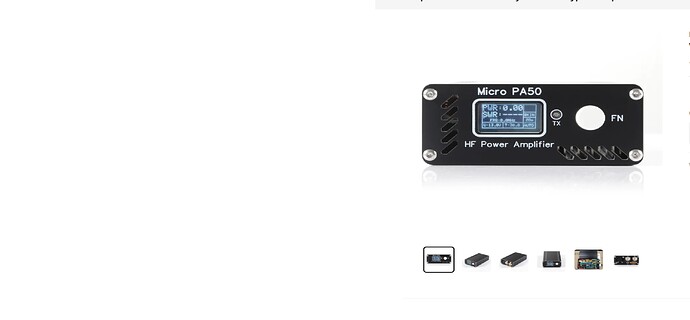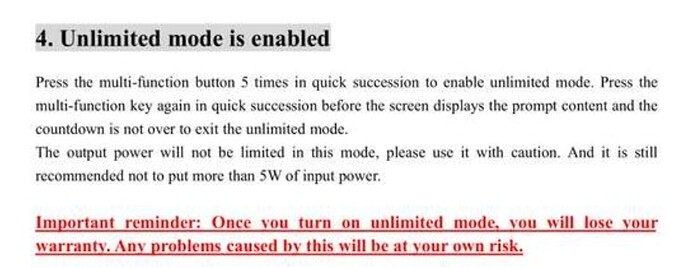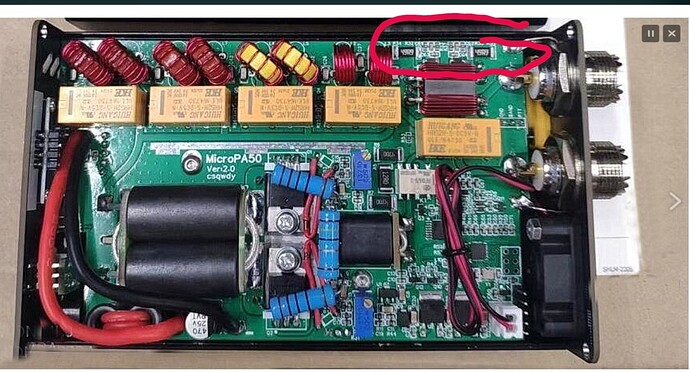Has anyone used this machine? sq9mdf
EDIT: Don’t buy this. The SWR protection is inaccurate and overzealous on all bands where you can’t get a match below 1.5:1. It shuts off the amp under normal operating conditions.*
I just got one on Friday and I took it out to activate a park on Saturday and have played with it in the shack at the QTH over the last couple of days.
Initial observations:
- The band sense works well. Double click the button to cycle through the delay time. I find 250ms is nicely usable.
- The SWR meter is a little finicky. Unlike on a transceiver, there is no foldback. The amplifier just shuts off and beeps if the SWR exceeds 2:1 and it’s really, really picky. You have to reset it to shut it up. For some reason, it does NOT want to feed my linked dipole when I have it set for 15 meters. My IC-705 and my FT-891 both insist the SWR is only 1.5:1, but the Micro PA disagrees and it’s really angry about it. I’ll try changing the length of the feedline to see if that makes a difference.
- It’s small. Smaller than you think. But it’s DENSE. It feels heavy. I think when I added up the weight, this amplifier+IC-705 was only about 7 ounces lighter than my FT-891. So, if you can handle an extra 7 ounces, you can get twice as much power for much less than half the price of this and the 705. But if I didn’t already have an 891, I’d be fine with just this and the 705.
- The fan is always running while it’s keyed up and it’s a little bit loud. Not noticeable outside, but quite noticeable inside. Not an ideal amp for the shack. But I’m happy with the compromise, because the price of a smaller package is active cooling. The only way to package it so small is to cool it aggressively, and this amp doesn’t get hot, not even on FT8 at 50 watts!
- I took it apart. It’s well built.
- Display is readable outside, but not with polarized glasses.
- 2.5 watts in gets you approximately 45 watts out according to the power meter while running FT8. 5 watts in occasionally trips the overload protection on SSB. I also checked it with my oscilloscope running into a 50 ohm dummy load and whistling into the mic it looks like 5 watts in on SSB usually comes out to around 50 watts RMS, but obviously it can peak over 50 watts. Wish the 705 had more steps in power output. The amp itself has no control for power output.
- No power switch. For portable operation, I don’t care about this.
- Runs happily off a 6ah lfp battery.
- I couldn’t get the control cable to work. Doesn’t matter. The RF sense is perfectly fine and it cuts down on the number of cables.
The number of times you push the button in quick succession cycles through the modes. One long push turns the PA on and off but leaves the power and SWR meters on. Don’t try to tune with the amp on. It won’t work. Of course, if you’re portable and using this amp as well as an adequately sized tuner you’re a masochist for carrying all that weight. I would recommend resonant antennas for this amp just because you’re going to need a QRO sized tuner for it anyway, so you may as well save the weight. It had no trouble driving my linked EFHW on 10-20 meters. I didn’t try 40 on the EFHW yet as I didn’t have enough space out my balcony. My linked dipole has all the intermediate bands between 40 and 10 and it drives every single one trouble free except for 15 meters for some strange reason.
Other reviewers have tested the output filters and found it to be clean. I won’t go into that. I don’t care. The filters are all there, the Chinese people aren’t stupid. They probably didn’t waste all the wire and ferrites just to have them do nothing.
For the price, I recommend it, especially if you don’t already own a QRO rig. It might turn out to be just the little problem solver you need to get that activation done. It’s good. Not great, just good enough. I no longer believe this is worthy of purchase. I think the SWR shutoff problem has gotten worse as I’ve used it more
Thanks for the interesting report. With many China PA, the maximum power is strongly dependent on the band. What is the measured output power at 10 m? What is the power at the battery with 12 volts?
73, Peter - HB9PJT
thanks for the many tips. I also have ANT end fed. check also 40m - in europe this is the main band for me. if it had built-in AT it would be a revelation did you try to supply 15V? sq9mdf
Okay, I played around with the amp a little more last night and I rescind my recommendation. This thing is unusable in its current state.
The erroneous SWR problem isn’t confined to just 15 meters. It happens on any band where the tuner can’t get the match below 1.5:1. It consistently reads at least .5 higher SWR than my tuner and both of my transceivers. Since it just shuts off and beeps at you instead of folding back, that makes this completely, utterly useless.
You CAN turn off the overpower protection, but you CANNOT turn off the SWR protection, so basically this thing is as good as a brick unless operated under the most pristine impedance match conditions imaginable. Even then, it’s a crap shoot because its SWR meter bounces all over the place. I think the problem is getting worse the more I use the amp.
There is no user manual and no technical support from the manufacturer. I left a crummy review on Aliexpress but I think we all know how that will work out.
Do not buy this. If you want more power at your summit, you may as well just haul an FT-891 with you.
Or be a proper radio ham and make your own PA specific to your SOTA needs.![]()
The description of the PA states, among other things, that the SWR protection can also be switched off. https://www.aliexpress.com/item/1005004740432217.html
73 Chris
Well, if it can be turned off, I haven’t figured out how to do it.
I’m seriously considering it. I mean, I have a pretty darn good enclosure to build one into now!
If you cannot disable it you should be able to slug the detector so it thinks 2:1 is 1.5:1 and you’ll be laughing then.
…and what if the connection itself does not have 50 ohm? ![]()
73 Armin
What do you mean by “slug the detector?”
There’ll be some kind of RF sampler in the output line with a couple of diodes to measure the outgoing RF and reflected RF. When the ratio of the reflected to output is too much the SWR protection will trigger. So there’ll be two voltages either into a comparator or two ADC inputs. You need to reduce the reflected voltage so the voltage it gives for 1.5:1 happens at 2:1 (or what you want).
Thanks! I’ll poke around in there with the oscilloscope and see what I can find. I might just need to disable the SWR detector altogether since it’ll probably involve removing a surface mount component.
- It’s 8 times, not 5. At least, that’s the case for the version of the firmware installed on mine.
- That doesn’t disable the SWR shut down. I tried operating it in Unlimited mode and it still shut itself off when it erroneously detected a high SWR.
- When you short press the button once, it just shuts off the alarm and allows you to use the amp again. Short pressing it before use does nothing.
I am pretty certain this amp will just be another version of the IRF520 / IRF530 Push Pull designs that been going around for a few years. If so its more like a 25 or 30w amp, higher than that the IMD will not be good.
These are low cost switching Mosfets which wont take much abuse, the designer of the protection likely had this in mind. May have designed to be dynamic protection i.e shuts down at 2:1 at 25W and 1.5:1 at 50w. Supply voltage may also feed into the dynamic protection, to assess supply current.
Test again with same antenna with 25w and see what happens…
73 Gavin
GM0GAV
Surely. But carefully constructed. The voltages for forward and reverse are present at the marked point.
73 Chris
You’re right. They’re IRF 530 mosfets. Briefly looking over the data sheet for those parts, this is not how I’d implement an RF output stage. Seems like I’d want something designed to be a bit more linear, maybe even something designed for RF applications. Looks to me like they just poached a design from some HAM who was probably just challenging themselves to design a workable amp from the cheapest parts available. So, unsophisticated folks with access to nice machinery because they’re in China, so they just designed a PCB for a circuit they found online, stuck some microcontrollers and cheap display in there, then shoved it in a box. I’ll try it at a lower power level and see what happens, but I suspect that ultimately I’m just going to recycle this or salvage it for components.




